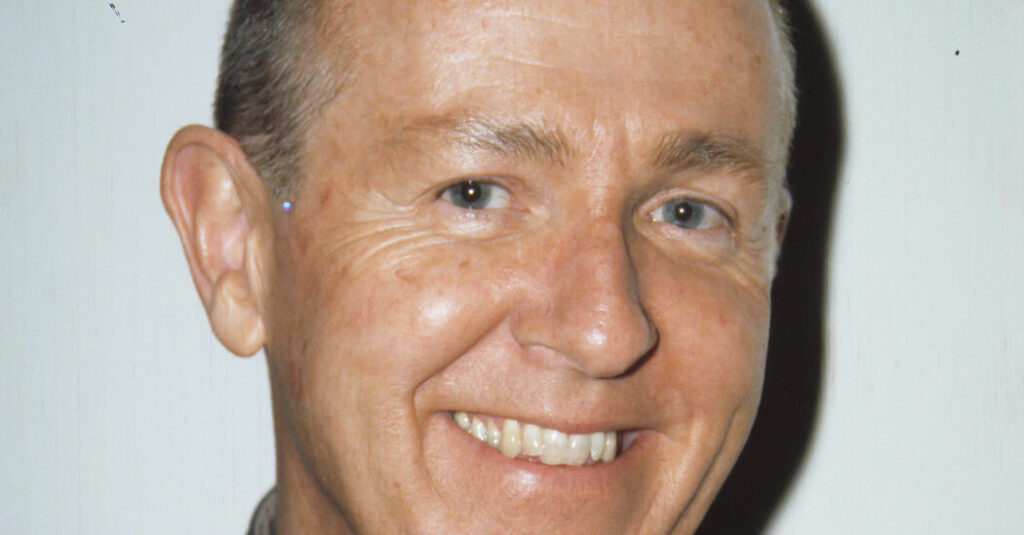Richard Lamparski, who, long before “Where Are They Now?” columns became ubiquitous in celebrity magazines and online, turned his obsession with forgotten stars into the “Whatever Became Of …?” series, 11 volumes of pop-culture nostalgia, movie trivia and, let’s be honest, schadenfreude, died on Nov. 8 in Santa Barbara, Calif. He was 93.
A friend, Jeffrey Hanna, said Mr. Lamparski died in a nursing home, where he had lived since a fall at his apartment in the spring. Once a gregarious writer who spent years traveling widely to entice often-reluctant subjects to speak with him, Mr. Lamparski spent the last decades of his life as a near recluse, shunning social interactions.
Each edition of the “Whatever Became Of …?” series, published from 1967 to 1989, included about 100 profiles of once-upon-a-time celebrities, mainly from film but also from sports, politics and other arts, accompanied by then-and-now photographs that revealed the sometimes cruel toll of time.
As 1960s America hurtled into the future at warp speed and in Technicolor, Mr. Lamparski’s thumbable black-and-white books offered a backward glance at the past through a catalog of, largely, historical footnotes.
His first book featured the Olympic figure skater turned movie heroine Sonja Henie (who married rich); Veronica Lake, an actress whose peekaboo hairstyle swept the country in the 1940s (she later waitressed in Manhattan); and Christine Jorgensen, one of the first people to undergo transition surgery (who was answering letters from people around the world unhappy about their gender).
Mr. Lamparski had an encyclopedic memory for Hollywood trivia and, in the days before the internet, was a resourceful investigator of obscure people, relying on word of mouth, street sightings and paging through the phone book.
“I’m a voyeur, an onlooker,” he said in a 2012 interview with the blog BoyCulture.
Beyond appealing to readers nostalgic for the America of newsreels and old movies, the books tapped into an emerging subculture of celebrity fans, including autograph hounds and memorabilia collectors. Mr. Lamparski counted himself among them; he was more motivated to meet celebrities than to make his mark as a film historian.
“I got to meet people I would not have dreamed I could ever meet,” he said in a 2010 interview with the blog The Showbiz Wizard. “I met Ish Kabibble!” he added, referring to the 1940s comedian and cornet player.
“I met Tokyo Rose! Brenda Frazier!” he continued, referring to a woman who broadcast Japanese propaganda during World War II and to an American debutante proclaimed Girl of the Year in 1938. “Walter Cronkite never met Brenda Frazier or Tokyo Rose.”
Mr. Lamparski first had the idea for “Whatever Became Of …?” in the 1950s, but it was met with broad skepticism. One publisher asked why, if the world had forgotten about these people, anyone would care what had become of them.
When Mr. Lamparski telephoned Buster Crabbe, a former star of 1930s science-fiction film serials, Mr. Crabbe told him: “You know how many years it’s been since I’ve been on a movie set? Who would be interested in Flash Gordon?”
Mr. Lamparski paused, and then answered, “Everyone!”
Mr. Crabbe, a former Olympic swimmer, made it into the first edition of “Whatever Became Of …?” accompanied by a photograph showing his still-buff physique, taken in the 1960s, when he was director of water sports at the Concord Resort Hotel in the Catskills.
The first outlet for Mr. Lamparski’s interviews was WBAI-FM in New York, which began broadcasting “Whatever Happened To …?” as a radio series in April 1965. Crown Publishers offered him a contract, but neither the publisher nor his editor showed much enthusiasm about the first installment. Then the “Today” show called, and he was interviewed by Barbara Walters and Hugh Downs.
“It just took off from there,” Mr. Lamparski said.
Richard Lamparski was born Richard Lynch on Oct. 5, 1932, in Detroit, the only child of Benjamin Lynch, who worked for an adding machine manufacturer, and Virginia (Downey) Lynch. His parents had changed the family name to Lynch to obscure their Polish roots, but Richard returned to the original, Lamparski, as an adult.
He later described his home life as “ghastly.” The family lived on the second floor of a house owned by his maternal grandmother, but his parents separated during his childhood. “It was very, very boring, and I think that’s why I was drawn to what I thought was glamour in the screen and famous people, and celebrities and travel and luxury,” he said in 2012.
At 19, he left for Los Angeles, where he worked various jobs in the television industry. During a stint as a press agent for the Ice Capades in the mid-1950s, he met a former silent movie star, Aileen Pringle, 36 years his senior. The two began a close but platonic relationship. (Mr. Lamparski was gay.)
“In those days, 58-year-old movie stars did not date 22-year-old guys,” he later recalled. “I mean, not that we were having an affair, but we did, we went out together like a couple. We were close buddies.”
Mr. Lamparski relocated to New York in 1960 and was still trying to scratch out a living on the periphery of the entertainment industry when, in 1964, the police raided his Upper West Side apartment. They confiscated 2,000 photographs and a camera, and charged him with possessing indecent pictures, according to The Daily News.
In the years before “Whatever Became Of …?” found its audience, Mr. Lamparski pursued interviews with forgotten stars. Many were has-beens from the silent era. He had learned how to charm them through his long association with Ms. Pringle.
Not all were equally welcoming. When Mr. Lamparski went to New Rochelle, N.Y., to interview Ken Maynard, a silent-era Western star, he brought along a photographer who was Black.
“Maynard lived in a trailer in a trailer park,” Mr. Lamparski recalled in 2010. “When he opened the door, he said, ‘He can’t come in here,’ meaning my assistant. He was very abusive. A terrible, pathetic old man. He was totally drunk, and I couldn’t get anything out of him.”
His interview with Dorothy Parker in 1966 was far more successful. Mr. Lamparski spent six months escorting the writer, then in her 70s, to the movies before sitting down to interview her at her apartment in a residential hotel on the Upper East Side of Manhattan. She dished about Hollywood and about the Round Table, circa 1919, at the Algonquin Hotel in New York.
“There was no truth in anything they said,” Ms. Parker said of the literary wits who populated the hotel bar. “They came there to be heard by one another. ‘Did you hear what I said last night?’”
She added: “People look at it rosily now, and it wasn’t. I promise you, it was not good. It was the terrible day of the wisecrack, so there didn’t have to be any truth.”
The 11th and final edition of “Whatever Became Of …?” was published in 1989. By then, readers had either moved on or were sating their appetites for then-and-now celebrity news in the pages of magazines like People and Us Weekly.
“Interest evaporated overnight,” Mr. Lamparski said. That year, he moved to Santa Barbara, where he withdrew from most professional and social engagements. He has no survivors.
In 2012, he said, “I haven’t seen another human being in about 14 years.”
After decades of interviewing celebrities, Mr. Lamparski added, he had become impatient with the mundane lives and interests of the people he knew, and had grown snappish toward friends. “I realized I didn’t need any companionship,” he said.
“I like talking to people on the phone, and I have pen pals all over,” he told BoyCulture. “But I don’t really need to socialize with anyone.”
Trip Gabriel is a Times reporter on the Obituaries desk.
The post Richard Lamparski, Author of ‘Whatever Became Of …?’ Books, Dies at 93 appeared first on New York Times.




